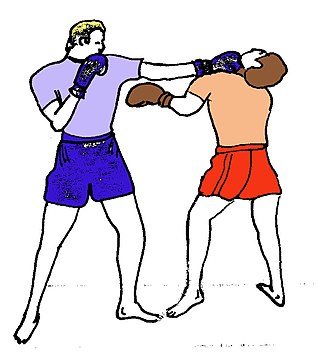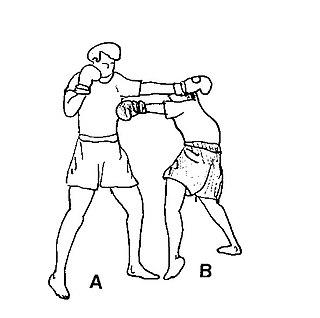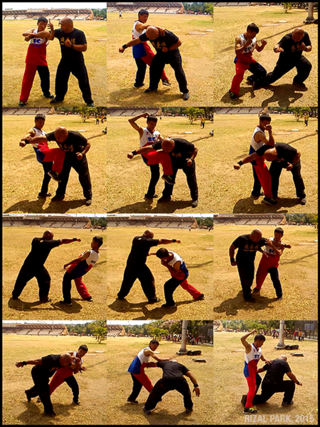
Boxing is a combat sport and a martial art in which two people, usually wearing protective gloves and other protective equipment such as hand wraps and mouthguards, throw punches at each other for a predetermined amount of time in a boxing ring.

Kickboxing is a full-contact combat sport based on punching and kicking. Kickboxing originated in the 1950s to 1970s. The fight takes place in a boxing ring, normally with boxing gloves, mouth guards, shorts, and bare feet to favor the use of kicks. Kickboxing is practiced for self-defense, general fitness, or for competition. Some styles of kickboxing include: Full contact karate, Muay Thai, Japanese kickboxing, Lethwei, Sanda, and Savate.

A kick is a physical strike using the leg, in unison usually with an area of the knee or lower using the foot, heel, tibia (shin), ball of the foot, blade of the foot, toes or knee. This type of attack is used frequently by hooved animals as well as humans in the context of stand-up fighting. Kicks play a significant role in many forms of martial arts, such as capoeira, kalaripayattu, karate, kickboxing, kung fu, wing chun, MMA, Muay Thai, pankration, pradal serey, savate, sikaran, silat, taekwondo, vovinam, and Yaw-Yan. Kicks are a universal act of aggression among humans.

Muay Thai, sometimes referred to as Thai boxing, is a Thai martial art and full-contact combat sport that uses stand-up striking, sweeps, and various clinching techniques. This discipline is known as the "Art of eight limbs", as it is characterised by the combined use of fists, elbows, knees and shins. Muay Thai became widespread internationally in the late 20th to 21st century, when Westernised practitioners from Thailand began competing in kickboxing and mixed-rules matches as well as matches under Muay Thai rules around the world. The professional league is governed by The Professional Boxing Association of Thailand (P.A.T.), sanctioned by The Sports Authority of Thailand (S.A.T.).

Filipino martial arts (FMA) refer to ancient and newer modified fighting methods devised in the Philippines. It incorporates elements from both Western and Eastern Martial Arts; the most popular forms of which are known as Arnis, Eskrima, and Kali. The intrinsic need for self-preservation was the genesis of these systems. Throughout the ages, invaders and evolving local conflict imposed new dynamics for combat in the islands now making up the Philippines. The Filipino people developed battle skills as a direct result of an appreciation of their ever-changing circumstances. They learned, often, out of necessity on how to prioritize, allocate and use common resources in combative situations. Filipinos have been heavily influenced by a phenomenon of cultural and linguistic mixture. Some of the specific mechanisms responsible for cultural and martial change extended from phenomena such as war, political and social systems, technology, and trade and practicality.

Arnis, also known as kali or eskrima/escrima, is the national martial art of the Philippines. These three terms are, sometimes, interchangeable in referring to traditional martial arts of the Philippines, which emphasize weapon-based fighting with sticks, knives, bladed weapons, and various improvised weapons, as well as "open hand" techniques without weapons.

A jab is a type of punch used in martial arts. Several variations of the jab exist, but every jab shares these characteristics: while in a fighting stance, the lead fist is thrown straight ahead and the arm is fully extended from the side of the torso. This process also involves a quick turn of the torso. It is an overhand punch; at the moment of impact, the pronated fist is generally held in a horizontal orientation with the palm facing the ground.

A strike is a directed, forceful physical attack with either a part of the human body or with a handheld object, intended to cause blunt or penetrating trauma upon an opponent.

Taekkyon,Taekgyeon, Taekkyeon, or Taekyun is a traditional Korean martial art.

Shadowboxing is a combat sport exercise in which a person throws punches at the air as though there is an opponent. Practised primarily in boxing, it is used mainly to prepare the muscles before the person training engages in stronger physical activity. Muhammad Ali once performed a now famous shadowboxing routine next to Howard Cosell for ABC's Wide World of Sports television cameras. Black Nova Scotian boxer George Dixon is widely credited for developing the technique.
A hook is a punch in boxing. It is performed by turning the core muscles and back, thereby swinging the arm, which is bent at an angle near or at 90 degrees, in a horizontal arc into the opponent. A hook is usually aimed at the jaw, but it can also be used for body shots, especially to the liver.

Pencak silat is an umbrella term for a class of related Indonesian martial arts. In neighbouring countries, the term usually refers to professional competitive silat. It is a full-body fighting form incorporating strikes, grappling, and throwing, in addition to weaponry. Every part of the body is used and subject to attack. Pencak silat was practiced not only for physical defense but also for psychological ends. There are hundreds of different pencak silat styles and schools which tend to focus either on strikes, joint manipulation, weaponry, or some combination thereof.

The Ragione di adoprar sicuramente l'Arme, si da offesa come da difesa was a famous treatise on fencing published by Giacomo di Grassi in 1570. The text was later translated into English and published again in 1594, as Di Grassi, His True Arte of Defence. The translation of Di Grassi was one of the three premiere fencing texts known from Elizabethan England.

A roundhouse kick is a kick in which the practitioner lifts the knee while turning the supporting foot and body in a semicircular motion, extending the leg striking with the lower part of the shin and/or the instep. The ball of the foot can also be used to strike the target and is preferable when power breaking thick boards. This type of kick is utilized in many different martial arts and is popular in both non-contact and full-contact martial arts competitions. The kick has many variations based on stance, leg movement, striking surface, and the height of the kick.
Peek-a-boo is a boxing style which received its common name for the defensive hand position, which are normally placed in front of the face, like in the baby's game of the same name. The technique is thought to offer extra protection to the face while making it easier to jab the opponent's face. The fighter holds their gloves close to their cheeks and pulls their arms tight against their torso. A major proponent of the style was trainer Cus D'Amato, who didn't use the term peek-a-boo and instead referred to it as a "tight defense." The style was criticized by some because it was believed that an efficient attack could not be launched from it.

Throughout the history of gloved boxing styles, techniques and strategies have changed to varying degrees. Ring conditions, promoter demands, teaching techniques, and the influence of successful boxers are some of the reasons styles and strategies have fluctuated.

Slipping is a technique used in boxing that is similar to bobbing. It is considered one of the four basic defensive strategies, along with blocking, holding, and clinching. It is performed by moving the head to either side so that the opponent's punches "slip" by the boxer.
Stances are a highly fundamental part of all Chinese Martial Arts. Wushu is characterized by low, wide stances designed for mobility and protection. Stability is another key concern of Chinese martial arts, and the wushu stances reflect this sensibility. There are five key stances utilized in both contemporary wushu and traditional wushu. Many others exist, and different styles of wushu prescribe a particular protocol for "correct" stance.

Tactics are very important to playing well in modern fencing and although technique is important in the sport, using an array of tactics will help fencers make the most of that technique.

Suntukan is the fist-related striking component of Filipino martial arts. In the central Philippine island region of Visayas, it is known as Pangamot or Pakamot and Sumbagay. It is also known as Mano-mano and often referred to in Western martial arts circles of Inosanto lineage as Panantukan. Although it is also called Filipino Boxing, this article pertains to the Filipino martial art and should not be confused with the Western sport of boxing as practiced in the Philippines.

















